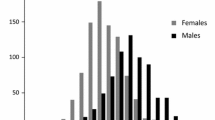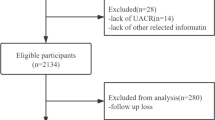Abstract
A follow-up study on 5442 inhabitants (2699 men, 2743 women) was conducted to determine the association between urinary Ca excretion level and mortality of the general population of three different areas of the Jinzu River basin area, namely, non-Jinzu River, mixed, and the Jinzu River water systems, over a period of 6127 d. More than 98% of the subjects were followed completely in each area. In comparison with the low- and high-Ca-excretion groups (cutoff values; 25.1 mg/dL in men, 20.4 mg/dL in women), the mortality rates per 1000 person-years and standardized mortality ratios (SMRs) tended to be greater in the low-Ca-excretion groups than in the high-Ca-excretion groups in both sexes for each of the three areas. Moreover, Cox’s hazard ratios in men and women of the three areas exhibited negative values, 0.99 except for men of the mixed water system. These values were statistically significant in both sexes for the Jinzu River water system and in women for the non-Jinzu River water system. We conclude that the life-span becomes shorter as urinary Ca excretion levels become lower.
Similar content being viewed by others
References
K. Nogawa, E. Kobayashi, R. Honda, A. Ishizaki, S. Kawano, and H. Matsuda, Renal dysfunctions of inhabitants in a cadmium-polluted area, Environ. Res. 23, 13–23 (1980).
K. Nogawa, Itai-itai disease and follow-up studies, in Cadmium in the Environment, Part 2. Health Effects, J. O. Nriagu, ed., Wiley-Interscience, New York, pp. 1–37 (1981).
H. Nakagawa, M. Tabata, Y. Morikawa, M. Senma, S. Kawano, and T. Kido, High mortality and shortened life-span in patients with Itai-itai disease and subjects with suspected disease, Arch. Environ. Health 45, 283–287 (1990).
H. Nakagawa, M. Nishijo, Y. Morikawa, M. Senma, S. Kawano, M. Ishizaki, et al. Urinary β2-microglobulin concentration and mortality in a cadmium-polluted area, Arch. Environ. Health 48, 428–435 (1993).
M. Nishijo, H. Nakagawa, Y. Morikawa, M. Tabata, M. Senma, K. Miura, et al. Mortality of inhabitants in an area polluted by cadmium: 15 year follow up, Occup. Environ. Med. 52, 181–184 (1995).
K. Iwata, H. Saito, M. Moriyama, and A. Nakano, Association between renal tubular dysfunction and mortality among residents in a cadmium-polluted area, Nagasaki, Japan, Tohoku J. Exp. Med. 164, 93–102 (1991a).
K. Iwata, H. Saito, and A. Nakano, Association between cadmium-induced renal dysfunction and mortality: further evidence, Tohoku J. Exp. Med. 164, 319–330 (1991b).
K. Iwata, H. Saito, M. Moriyama, and A. Nakano, Follow up study of renal tubular dysfunction and mortality in residents of an area polluted with cadmium, Br. J. Ind. Med. 49, 736–737 (1992).
M. Fukushima and M. Sakamoto, Studies on some urinary screening tests for renal dysfunction induced by cadmium exposure. 1. Determination of glucose in urine by o-toluidine boric acid meted. 2. Examination of the urinary protein determination by Kingsbury-Clark’s turbidity method, J. Juzen Med. Assoc. 83, 733–748 (1974) (in Japanese).
T. Osawa, E. Kobayashi, Y. Okubo, Y. Suwazono, T. Kido, and K. Nogawa, A retrospective study on relation between renal dysfunction and cadmium concentration in rice in individual hamlets in the Jinzu River basin, Toyama Prefecture, Environ. Res. 86, 51–59 (2001).
B. G. Leifsson and B. O. Ahren, Serum calcium and survival in a large health screening program, J. Clin. Endocrinol. Metab. 21, 2149–2153 (1996).
C. W. Broner, G. L. Stidham, D. F. Westenkirchner, and E. A. Tolley, Hypermagnesemia and hypocalcemia as predictors of high mortality in critically ill prediatric patients, Crit. Care Med. 18, 921–928 (1990).
T. K. Desai, R. W. Carlson, and M. A. Geheb, Prevalence and clinical implications of hypocalcemia in acutely in patients in a medical intensive care setting, Am. J. Med. 84, 209–214 (1988).
N. Cardenas-Rivero, B. Chernow, M. A. Stoiko, S. R. Nussbaum, and I. D. Todres, Hypocalcemia in critically ill children, J. Pediatr. 114, 946–951 (1989).
R. P. Magro, A. C. Lopez, C. J. Lopez-Herce, M. M. Campos, and S. L. Perez, Metabolic changes in critically ill children, An. Esp. Pediatr. 52, 143–148 (1999).
Author information
Authors and Affiliations
Rights and permissions
About this article
Cite this article
Kobayashi, E., Okubo, Y., Suwazono, Y. et al. Association between urinary calcium excretion level and mortality in inhabitants of the Jinzu River basin area of Japan. Biol Trace Elem Res 89, 145–153 (2002). https://doi.org/10.1385/BTER:89:2:145
Received:
Revised:
Accepted:
Issue Date:
DOI: https://doi.org/10.1385/BTER:89:2:145




